Huang Tingjian (黃庭堅): Vers a Fenyők és Szél Csarnokáról 《松風閣詩》
index | publikációk | facebook oldalunk
Song Feng Ge Shi (Vers a Fenyők és Szél Csarnokáról) (松風閣詩) was written by Huang Tingjian (黃庭堅, 1045-1105) in 1102. It presents a sense of melancholy within a mood of delight. Huang first described the scenery surrounding the Hall of Pines and Wind and his enjoyment with friends. Then he expressed a strong regret that Su Shi, his great friend and mentor could not share the delightful time with him as Su passed away in the year before. Finally, Huang hoped to be able to free himself from the entanglement of his current situation and go with friends together on a boating trip. This masterpiece is kept in National Palace Museum, Taipei (台北故宮博物院).
Huang Master is also regarded as a particularly fine and creative calligrapher of the Song Dynasty. His xingshu (行书) displays a sharpness and aggression that is instantly recognizable to students of Chinese calligraphy. His calligraphic piece Biographies of Lian Po and Lin Xiangru epitomises a technique today known as "flying-white (飞白)" "when writing calligraphy, the areas within a brushstroke where the brush fails to leave a full measure of ink and streaks of white paper or silk appear".
Please visit National Palas Museum website where you can find these copies into the large format (which are fine for your shufa practice :-)). The translation of Song Feng Ge Shi (松風閣詩) below on this page. Special thanks Qiu Xinxian (邱馨賢 老師) for the modern Chinese translation. The english version was finished on the basis of Dr. Alfreda Murck’s work.
宋 黃庭堅 自書松風閣詩
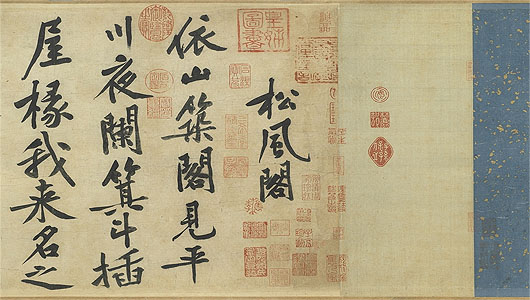
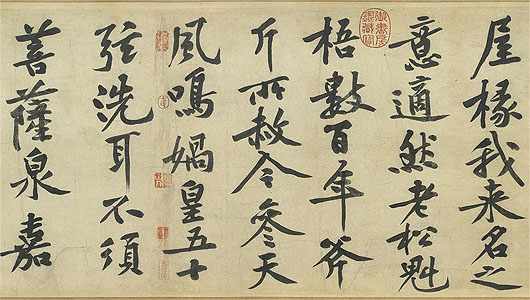
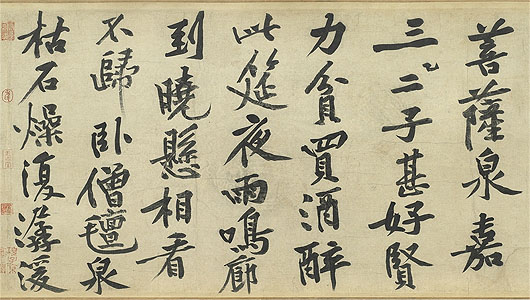
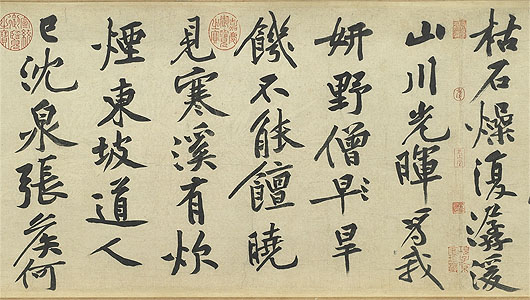
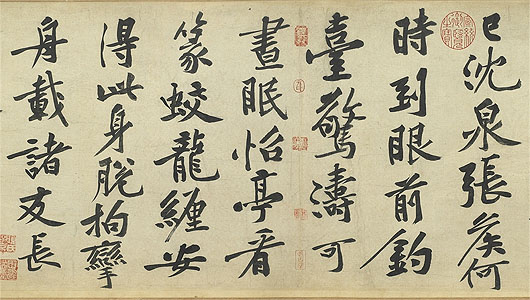
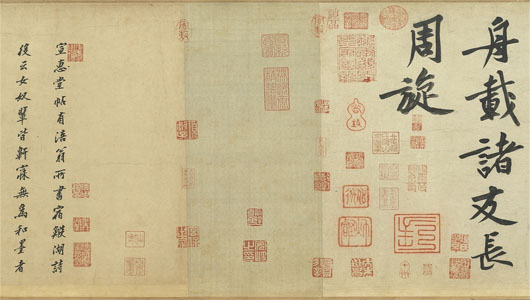
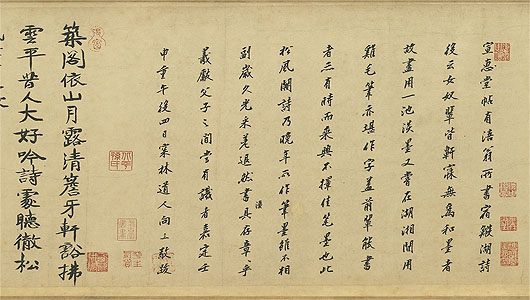
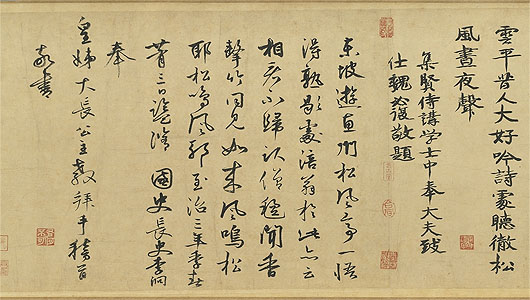
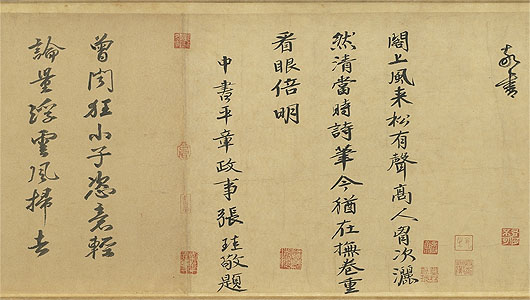
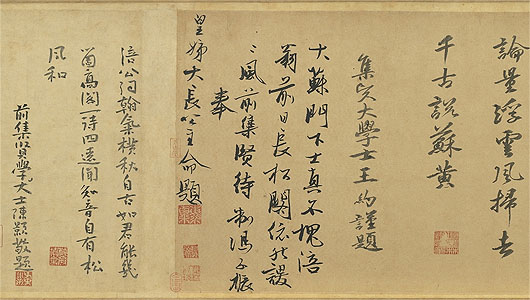
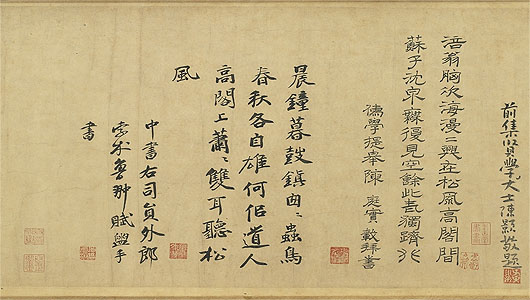
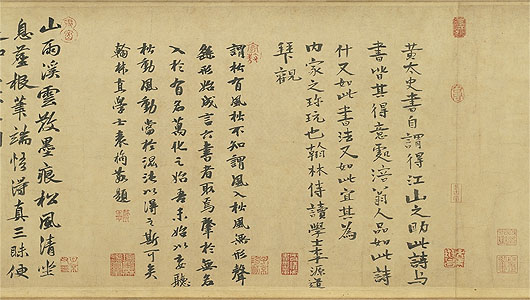
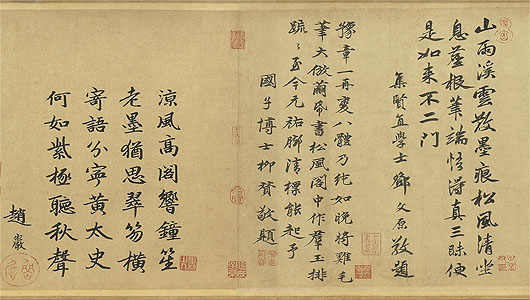
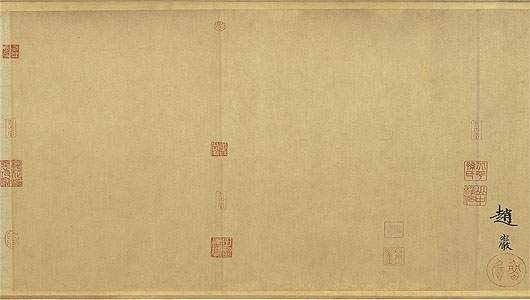
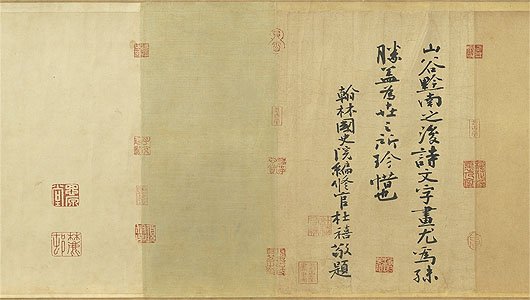
Song Feng Ge Shi (Vers a Fenyők és Szél Csarnokáról) (松風閣詩)
Translation
依山築閣見平川。
這座依著 (樊山Fán shān, 湖北鄂州Hú Běi E Zhōu之西)山形而建築的閣樓,遠眺可望見平緩的河川。
On the slope of the mountain was raised a hall (or pavilion) that overlooks a level stream.
夜闌箕斗插屋椽。
深夜,屋簷外能看到滿天星斗。 箕是中國古代星官之一,位於現代星座劃分的人馬座 (Sagittarius). 斗是中國古代星官名,斗星官共由五星組成,位於現代星座的武仙座 (Hercules) 和巨蛇座 (Serpens) 斗或指北斗星七星 (Big Dipper in Constellation Ursa Major)。古代人把這七星聯系起來想象成為古代舀酒的斗形。
Late at night stars of Sagittarius, Hercules and Serpens stick between the rafters.
我來名之意適然。
我來到這裡,爲它命名(為『松風閣』),心情格外安然自在。
I came and named the Hall (Hall of the Pines and wind), and I am quite happy with the name I’ve chosen.
老松魁梧數百年。
這座閣樓外有數株挺拔的老松樹,在此已矗立了數百年。
Ancient pine trees of gigantic statue, hundreds of years old
斧斤所赦令參天。
所幸當初能免遭砍伐,才能有今天高聳入雲的雄偉姿態。
Those spared the woodcutter’s axe reach to the sky today.
風鳴媧皇五十弦。
在這裡的風聲,如同天神女媧撥彈五十弦琴般悅耳,
The wind sounds like Queen Wa’s fifty strings harp.
洗耳不須菩薩泉。
所以不必到旁邊的菩薩泉取山泉’洗滌’耳朵 。(’洗耳恭聽’表示細心地聆聽。隱喻這裡已經有好悦耳的風聲。)
To’ wash’ ears you do not need the water of Bodhisattva Spring. (The sounds at the Hall are already worthy of listening and you don’t need to go to Spring.)
嘉二三子甚好賢。
跟我一同前來的這二、三個朋友,都是樂好賢雅之士。
Accompanying me are two or three admirable friends.
力貧買酒醉此筵。
雖然環境貧乏, 好友買酒暢飲,不醉無歸。
Despite hardship, they still buy wine (to entertain friends) and get drunk.
夜雨鳴廊到曉懸。
晚上開始下起了雨,聽著走廊上響亮的雨滴聲,看來這雨是會下到天亮
Night rain sounds along the walkways, hanging until dawn.
相看不歸臥僧氈。
我們彼此看一看,乾脆今晚就在寺院住下(卧在寺院的毛毡上)。
Looking at one another, we decided not to return home, reclining on a monk’s felt blanket (ie staying overnight in the temple).
泉枯石燥復潺湲。
經過一夜新雨,原來乾枯的溪澗泉石,又變得流水潺潺了。
A dry spring with parched rocks has water flowing again.
山川光暉為我妍。
山川景色,更顯清亮耀眼,彷彿爲我而美麗。
The luminosity of the mountains and rivers are for us to admire.
野僧旱饑不能饘。
這裡的山僧此時雖然又飢又渴,但還不能吃早粥。
Amid drought and famine, monks in the wilderness have nothing to eat not even morning congee.
曉見寒溪有炊煙。
晨早溪邊已經可以看到煮食的炊煙了。
At dawn near the cold stream rises the smoke from kitchen chimneys (some people are cooking).
東坡道人已沈泉。
蘇東坡道人已在九泉之下 (他已經過世了) 。
Dongpo, a man of Dao, has already sunk to the springs (ie has passed away).
張侯何時到眼前。
而好友張耒也沒在我身邊!
When will Mr Zhang (Zhāng lěi 張耒) arrive before my eyes ?
釣臺驚濤可晝眠。
聽到「釣臺」壯闊的海濤聲,便想閉目養神打個盹。
Listening to the sounds of the waves washing onto ‘Fishing Platform’, we want to sleep through the day.
怡亭看篆蛟龍纏。
到「怡亭」,看 (李陽冰的) 篆書,(那勁健有力的書法,真有如) 蛟龍翻騰纏繞。
At ‘Leisure Pavilion’ looking at seal scripts that look like tangling dragons.
安得此身脫拘攣。
多希望我能脫去這身塵間枷鎖。
How can this life avoid being seized and bound ?
舟載諸友長周旋。
與我的好友們經常乘船出遊,那將會是多麼美好呀!
Boats carry my friends on long, revolving journey.
Huang Tingjian (黃庭堅) (1045–1105), also known as Lǔ Zhí (魯直), Shān Gǔ (山谷), Fú Wēng (涪翁). He was a native of Hóng Zhōu Fēn Níng (洪州分寧) (now Jiangxi Xiushui County 江西修水縣). Huang was a Chinese calligrapher, poet, scholar and government official of the Song Dynasty. He was one of the Four Calligrapher Masters of the Song Dynasty (宋四大家).
Huang Tingjian passed his imperial Chin-shih examination (登進士第) in 1067 and was granted some posts in the government. At the time, there were two major parties, a “reform” party lead by Wang Anshi (王安石) and a “conservative” party, which included prominent officials such as Sima Guang (司馬光), Ouyang Xiu (歐陽修) and Su Shi (蘇軾). As Emperor Shenzong (神宗) increasingly favoured Wang Anshi’s New Policies, as they were known, their opponents suffered politically. This included exile for Su Shi, beginning in 1080 to Hangzhou. Huang Tingjian was falsely accused of conspiracy. After 1086, Wang Anshi’s party was out of favour, and Wang Anshi himself was forced into retirement. Huang and other exiles were recalled from their places of banishment.
However, Su Shi and Huang Tingjian were repeatedly caught up in the political in-fighting in the Imperial Court and had to endure several cycles of exile and pardon.
Su died in 1101 and Huang died in 1105 in Yí zhōu (宜州)(now Guǎngxī Province廣西).
Special features of Huang’s calligraphy
Huang’s calligraphy is bold, magnificent and graceful in style. He formed his own distinctive methods for structuring characters which include concentrating strokes within the centre of the character and creating outstretched strokes radiating toward the four corners. He also had the habit of making wavering or overstretched strokes (一波三折).
Huang emphasized the importance of yun (韵) (grace or good taste).
During his exile, Huang was inspired by people rowing a boat forcefully against water current. This helped him to wield his brush better and express himself much more effectively.
他被貶到戎州期間,曾說道:在僰道,舟中觀長年蕩槳,群丁拔棹,乃覺少進,意之所到,則能用筆。
Huang’s calligraphy is always fresh and innovative. Each and every stroke of his writing has its own form and postures. Some words appear 2 or 3 of times in Sōng Fēng Gé Shī. The following shows that each word is written differently.
Sōng Fēng Gé Shī has been studied by numerous scholars and calligraphers for the last 913 years. Professor WONG Wai Cheong (黃維琩教授), my teacher, devoted a huge amount of effort studying the calligraphy of Huang. Below is a good example of his work which shows yun gracefully.

